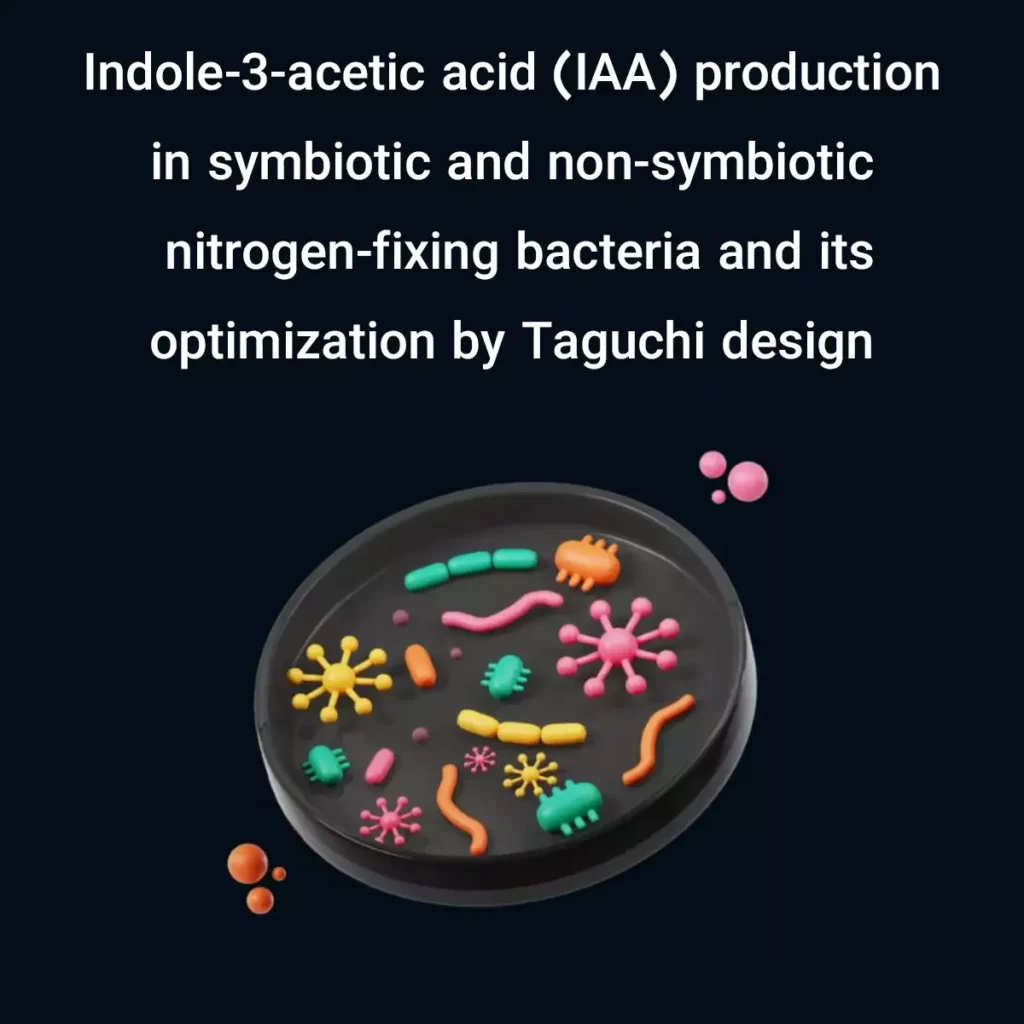

Authors: Dariush Shokri, Giti Emtiazi
Publication date: 2010/9
Journal: Current microbiology
Volume: 61
Pages: 217-225
Publisher: Springer-Verlag
Description
Production of Indole-3-acetic acid (IAA) in 35 different symbiotic and non-symbiotic nitrogen-fixing bacteria strains isolated from soil and plant roots was studied and assayed by chromatography and colorimetric methods. These bacteria included Agrobacterium, Paenibacillus, Rhizobium, Klebsiella oxytoca, and Azotobacter. The best general medium and synergism effects of isolates for IAA production were investigated. Effects of different variables containing physical parameters and key media components and optimization of condition for IAA production were performed using the Design of Experiments. Qualitek-4 (W32b) software for automatic design and analysis of the experiments, both based on Taguchi method was used. The results showed that Rhizobium strains, symbiotic, and Paenibacillus non-symbiotic bacteria yielded the highest concentrations of IAA (in the range of 5.23–0.27 and …
Click here to view this article
- Bric JM, Bostock RM, Silverstone SE (1991) Rapid in situ assay for indoleacetic acid production by bacteria immobilized on a nitrocellulose membrane. Appl Environ Microbiol 57:535–538CAS PubMed Google Scholar
- Cattelan AJ, Hartel PG, Fuhrmann JJ (1999) Screening for plant growth-promoting rhizobacteria to promote early soybean growth. Plant Cell Physiol 63:1670–1680CASGoogle Scholar
- Datta C, Basu PS (2000) Indole acetic acid production by a Rhizobium species from root nodules of a leguminous shrub. Microbiol Res 155:123–127CAS PubMed Google Scholar
- Ahmad F, Ahmad I, Khan MS (2005) Indole acetic acid production by the indigenous isolates of Azotobacter and fluorescent Pseudomonas in the presence and absence of tryptophan. Turk J Biol 29:29–34CAS Google Scholar
- Diemaite J (2004) Peculiarities of the formation of indole-3-acetic acid–protein complexes in yeast Saccharomyces cerevisiae plasmalemma. Biologija 10:36–38Google Scholar
- Garrity GM, Brenner DG, Krieg NR (2005) Bergey’s manual of Systematic Bacteriology. Vol. 2. Part. A. Springer, New YorkGoogle Scholar
- Glickmann E, Dessaux Y (1995) A critical examination of the specificity of the Salkowski reagent for indolic compounds produced by phytopathogenic bacteria. Appl Environ Microbiol 61:793–796CAS PubMed Google Scholar
- Kang BR, Yang KY, Cho BH et al (2006) Production of indole-3-acetic acid in the plant-beneficial strain Pseudomonas chlororaphis O6 is negatively regulated by the Global Sensor Kinase GacS. Curr Microbiol 52:473–476Article CAS PubMed Google Scholar
- Kawaguchi M, Syono K (1996) The excessive production of indole-3-acetic acid and its significance in studies of the biosynthesis of this regulator of plant growth and development. Plant Cell Physiol 37(8):1043–1048CAS PubMed Google Scholar
- Kittell BL, Helinski DR, Ditta GS (1989) Aromatic aminotransferase activity and indoleacetic acid production in Rhizobium meliloti. J Bacteriol 171:5458–5466CAS PubMed Google Scholar
- Leveau JHJ, Lindow SE (2005) Utilization of the plant hormone indole-3-acetic acid for growth by Pseudomonas putida strain 1290. Appl Environ Microbiol 71:2365–2371Article CAS PubMed Google Scholar
- Lindow SE, Desurmont C, Elkins R et al (1998) Occurrence of indole-3-acetic acid-producing bacteria on pear trees and their association with fruit russet. Phytopathology 88:1149–1157Article CAS PubMed Google Scholar
- Matsukawa E, Nakagawa Y, Iimura Y et al (2007) Stimulatory effect of indole-3-acetic acid on aerial mycelium formation and antibiotic production in Streptomyces spp. Actinomycetologica 21:32–39Article CAS Google Scholar
- Phi QT, Park SY, Park SH et al (2008) Isolation and characterization of transposon-insertional mutants from Paenibacillus polymyxa E681 altering the biosynthesis of indole-3-acetic acid. Curr Microbiol 56(5):524–530Article CAS PubMed Google Scholar
- Robinson M, Riov J, Sharon A (1998) Indole-3-acetic acid biosynthesis in Colletotrichum gloeosporioides f. sp. Aeschynomene. Appl Environ Microbiol 64:5030–5032CAS PubMed Google Scholar
- Spaepen S, Vanderleyden J, Remans R (2007) Indole-3-acetic acid in microbial and microorganism-plant signaling. FEMS Microbiol Rev 31(4):425–448Article CAS PubMed Google Scholar
- Sreenivas RR, Prakasham RS, Krishna (2004) Xylitol production by Candida sp.: parameter optimization using Taguchi approach. Process Biochem 39:951–956Article Google Scholar
- Sridevi M, Mallaiah KV (2007) Production of indole-3-acetic acid by Rhizobium isolates from sesbania species. Afr J Microbiol Res 1(7):125–128Google Scholar
- Suzuki Sh, He Y, Oyaizu H (2003) Indole-3-acetic acid production in Pseudomonas fluorescens HP72 and its association with suppression of creeping bentgrass brown Patch. Curr Microbiol 47:138–143Article CAS PubMed Google Scholar
- Teale WD, Paponov IA, Palme K (2006) Auxin in action: signaling, transport and the control of plant growth and development. Mol Cell Biol 7:847–859